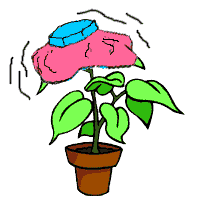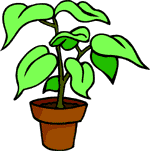
How to re-pot tired houseplants
Without the fuss, of course
By Marion Owen, Fearless Weeder
for PlanTea, Inc. and
Co-author of Chicken Soup for the Gardener's Soul
FEATURE ARTICLE:

Tom Hanks' "Power of Four" solution
More good stuff:
Who is Marion Owen?
FAQs about PlanTea
Search Marion's articles, tips and recipes
Why grow organic?
News and press releases
Read love letters
How to link to this site
Need a speaker?
How to contact Marion
Visiting Alaska?
Come to Kodiak Island!
Go to home page

Marion's UpBeet Gardener
Newsletter has been
replaced by Marion's blog
which you can find at:
www.marionowen.wordpress.com


Did you know that July 27 is a special day? Mark your calendars: It's
Take Your Houseplant for a Walk Day.
Indoor plants need special attention, just like kids and, dogs. Give them
water, plant food and, the right kind of light and they'll thrive. And,
just like kids outgrow tennis shoes, plants outgrow their pots.
How can you tell if a plant is pot-bound?

If your indoor potted plants have any of the following characteristics,
they may be pot-bound. Pot-bound roots have outgrown their container and
are starting to circle around the inside or poke out the drainage holes
in search of more growing room.
- Stunted
- Deformed
- Pale and dull
- Top-heavy
- Generally declining
- Water drains quickly through soil
To see for yourself, tilt the plant on its side and gently slide the
plant a few inches out of the pot. If the roots look like ropes winding
around in circles or they're matted at the bottom the plant's overdue
for a change. The solution is "stepping up" -- moving the plant
to a larger pot. By stepping up, you fix several problems at once: restricted
root space, replenish tired potting soil and you make the plant look better
in a container more in scale with its larger size.
Which container is best?
Resist the urge to move a plant to a substantially bigger pot. Select
one a couple of inches bigger. If you use too large a container, the extra
soil will soak up too much water, the plant’s roots will grow more
than necessary (like moving into a larger house and filling the space
with stuff) and foliage and flower growth will decrease.
|
- - -
- - - - - - - - - - - - - - - - - |
Re-Potting, Step By Step (I promise)
1) First you'll need to identify pot-bound plants. Gently roll or tap the container to loosen the plant and gently ease it out. Tip: Dry soil tends to hang onto the inner walls of the container, so watering your plant help grease the skids a little. Catch it in your other hand, with the foliage peeking between your fingers and the surface of the root ball supported in your palm. If the plant is a giant one, such as a fern, fig, or avocado tree, lay it over onto a tarp or newspapers spread on the floor.
|
Tired
of bugs buzzing around? |
2) With your fingers, carefully loosen the roots at the base and along
the sides of  the root ball. At this point, many experts say to use a knife
to split the lower third of the root ball to encourage new roots to grow
outward and down, rather than to keep spiraling. I say, put the knife
away and use your fingers. Using a knife to hack and slash at a plant's
root system is overkill. If you find any dead or damaged roots however,
use pruning shears to trim them off.
the root ball. At this point, many experts say to use a knife
to split the lower third of the root ball to encourage new roots to grow
outward and down, rather than to keep spiraling. I say, put the knife
away and use your fingers. Using a knife to hack and slash at a plant's
root system is overkill. If you find any dead or damaged roots however,
use pruning shears to trim them off.
3) Center the plant in the new, larger container, making sure it’s
upright. There's nothing like going through the whole process only to
gaze at your plant a month later to see that it's leaning in one direction.
Buy a high quality potting soil and adjust the soil level so the top of
the root ball is about 1/2 inch below the rim of the pot; more for larger
plants. Using your hand, sift new potting soil in around the plant and
firm it with your fingers. Tip: Those flexible cutting boards makes
the job of sifting soil around the plant easier, and cleaner!

Water the plant until water runs out of the drainage holes. This will
help settle the soil and give it good contact with the roots. Add more
soil if necessary.
Re-potting your indoor plants is like sending it to a health spa. It really
improves overall plant health. We tend to ignore indoor plants, treating
them like green statues, until they look so awful there's no way you can
not see them. Take some time this year to make a difference in your houseplant's
life!
Thanks for visiting and please stop by again. I'll put the coffee on!
Meet Marion Owen /// Learn about PlanTea /// Online Catalog /// Articles, Tips, Recipes /// Get free UpBeet Gardener newsletter /// Read current issue /// Listen to radio show /// Read news and press releases /// More resources and links /// Learn why 'grow organic?' /// View guidelines for retailers /// Read love letters /// Book Marion as a speaker /// Site map /// How to link to us /// Contact us /// Go to home page
PlanTea: The organic plant food in tea bags. http://www.plantea.com
Copyright ©1996 to present: PlanTea, Inc. All Rights Reserved. PO Box 1980, Kodiak, AK 99615-1980 USA
Questions or comments? marion@plantea.com Phone: Toll Free: 1-800-253-6331 (US and Canada); 907-486-2500